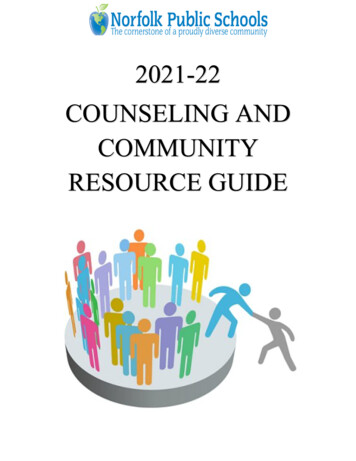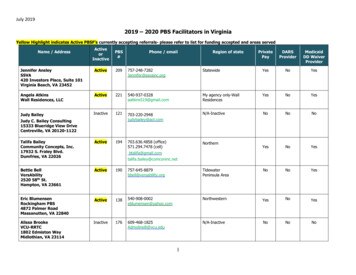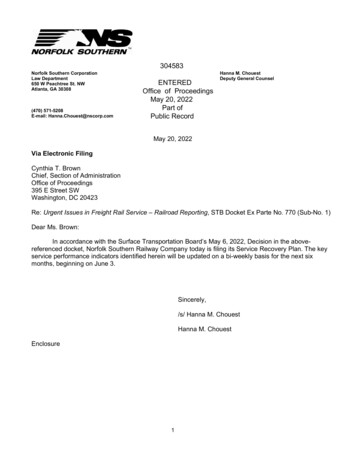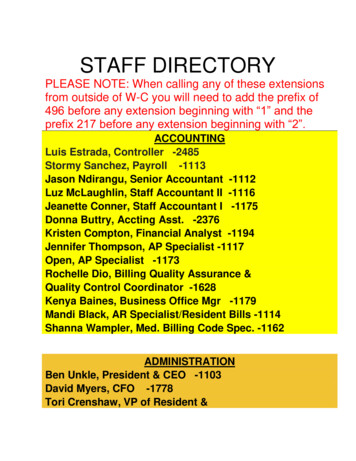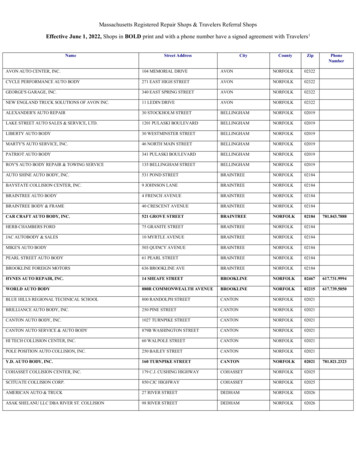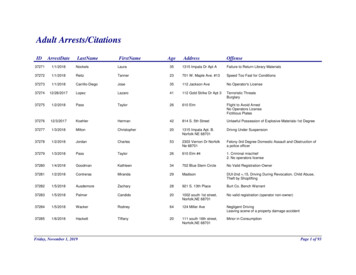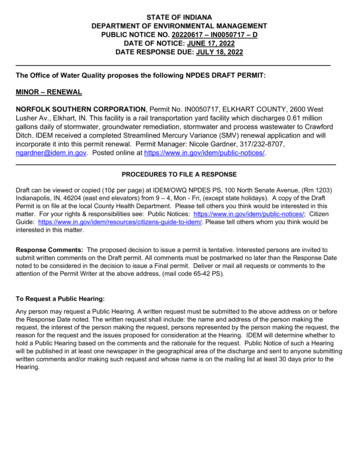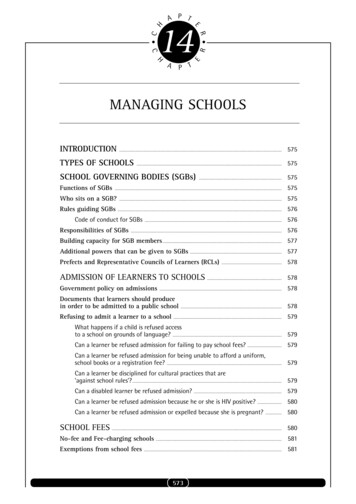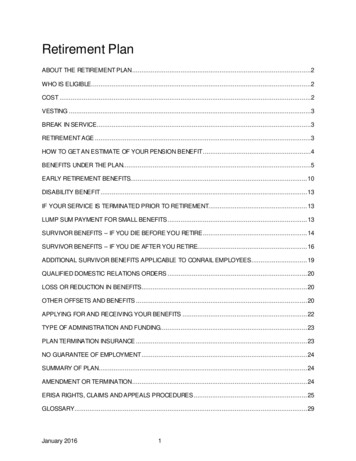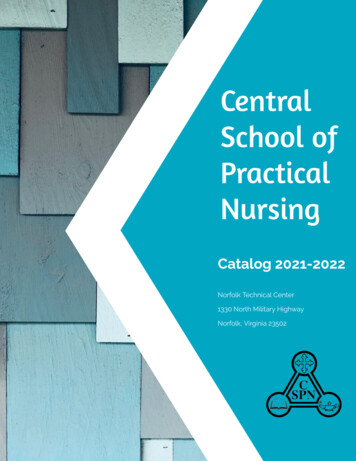
Transcription
CentralSchool ofPracticalNursingCatalog 2021-2022Norfolk Technical Center1330 North Military HighwayNorfolk, Virginia 23502
History of Central School of PracticalNursing02Nearly 330 years after the British founded the City of Norfolk, Virginia (1862), it continues tobe a port of international prominence. Being the largest natural harbor in the world isan important reason why Hampton Roads is a leading center of international trade andwhy the world’s largest naval base is located in Norfolk.The history of practical nursing education in Norfolk had its beginning in 1946, when Norfolk CitySchools and Leigh Memorial Hospital enrolled their first class. This twelve- month program becamethe first school of practical nursing in Virginia. It was the first school in the United States to beconducted in a hospital under the sponsorship of vocational education and the first school toreceive national accreditation (1947) by the National Association for Practical Nurse Education. Thisaccreditation was maintained until the National League for Nursing instituted its accreditationprogram for practical nursing programs. Both the National Federation of Licensed Practical Nursesand the American Nurses’ Association supported accreditation by the National League for Nursing.In 1961, a second twelve-month program in practical nursing was established, through thecooperation of Norfolk City Schools and Norfolk General Hospital. It received the Virginia Board ofNursing approval in 1962.In September 1968, the Norfolk Technical Vocational Center (NTVC) opened and with it, the NTVCSchool of Practical Nursing. This was an eighteen-month program for high school seniors. Theprogram opened with tentative approval granted by the Virginia Board of Nursing and, in 1970,received full approval.Early in the 1970s, the program at Leigh Memorial Hospital was phased out and the program atNTVC was expanded and renamed Central School of Practical Nursing (CSPN). The programconsisted of two components:Secondary: This was a high school extended program, which covered a calendar period of 18months, divided into two nine-month segments. The first phase, known as Level I (pre-clinical)ran concurrently with the high school schedule. During this time, the students attended classat NTVC for three hours each day and concurrently attended the home school. The secondphase, known as Level II (clinical), began in August and ended in March. During Level II, thestudents received clinical experiences in selected hospitals.Post-secondary: This component covered a calendar period of 12 months, which was dividedinto an 18-week pre-clinical phase and a 32-week clinical phase. During the pre-clinical phase,students attended classes at NTVC for six hours per day, and during the clinical phase,students had 35 hours per week of combined clinical experience and related theory. Thirty-fivepost-secondary students were enrolled in classes which began in September and March ofeach academic year.
History of Central School of PracticalNursing03Enrollment of post-secondary students declined in the late 1980s, and the decision was made in1987 to eliminate the 12-month post-secondary program.The National League for Nursing (NLN) granted initial accreditation in 1975. Accreditation has beenmaintained, first with the NLN, then with the National League for Nursing Accrediting Commission(NLNAC), and now the Accreditation Commission for Education in Nursing (ACEN). In 2013, CSPNreceived a full eight year accreditation from ACEN.At the present time, CSPN offers an eighteen-month nursing program for high school seniors withadults students enrolled on a space-available basis.
General Information04
CalendarSEPTEMBER-OCTOBERLabor Day HolidaySecondary and Adult students begin Level IColumbus DayNOVEMBER -DECEMBERVeterans’ Day HolidayThanksgiving HolidayWinter BreakJANUARY-FEBRUARYNew Year’s HolidayMartin Luther King HolidayPresidents’ Day HolidayMARCH-APRILSpring BreakGraduation (Level II)MAY-JUNEMemorial Day HolidaySummer VacationJULY-AUGUSTSummer Conference for TeachersLevel II students return in August05
Philosophy of Learning (NPS/NTC)06We are committed to developing students who value learning and the “habits of the mind” (a mentaldiscipline practiced so that it becomes a habit or natural process) that will enable them to adjustsuccessfully to the changing world. We will accept the responsibility for engaging the entirecommunity in preparing life-long learners who are able to understand the world in which they liveand have the skills needed to learn and succeed throughout their lifetime. We will recognize, value,and build upon both the individual differences and the similarities in our students.Students will have learning experiences that respect and address the strengths and needs of ALLstudents. These learning experiences will be like those found in day-to-day life and based uponbroad concepts flowing from the general to the more specific. Students will learn to makeresponsible choices overcome challenges, and take responsibility for their own learning. Studentswill attain academic proficiency as defined by local, state, and national standards. Students will havemany opportunities to internalize and demonstrate their understanding of newly acquiredinformation, skills, and processes that are tied to rigorous academic standards.Each stakeholder has a role to play. All stakeholders will approach their relationships with student,parents, teachers, administrators, and community members with respect to promote a positivelearning experience.Administrators will provide support and instructional leadership by creating and maintaining a clearfocus on student achievement driven by the district’s vision. Well-prepared teachers, safe andsecure school facilities, sound and rigorous curriculum, adequate resources, and appropriatesupport services will be needed to create and maintain this focus. Administrators will be advocatesfor all students. Keeping the focus on student needs will ensure that educational opportunities tomeet world-class standards will always be available for all the students.Teachers will be knowledgeable of and competent in the content areas they teach and have theability to relate this content to the students’ past, present, and future learning experiences. Teacherswill utilize effective classroom management and evidence-based teaching strategies to ensurelearning at high levels for all students. They will use various assessments (formative andsummative) to determine students’ understanding and to implement and modify classroominstruction.Students must assume responsibility for their own learning if they are to be successful. Therefore,we expect that students will come to school prepared to learn. We expect all students will followthe established rules and contribute to a disciplined learning environment. Most importantly, eachstudent will be an active participant in the learning process.
Philosophy of Learning (NPS/NTC)07Parents must be active partners with schools to provide the support and assistance that will ensurethe success of their children. Parents’ responsibilities include supporting school rules, programs,and goals, championing homework, showing an interest in their child’s educational experiences, andnever giving up on their child.Community members must embrace and support ongoing efforts to provide rigorous academicopportunities to children. The progress and condition of the community is dependent upon theeducational success realized by its citizens.By implementing this philosophy, Norfolk Public Schools (and NTC) will meet its vision to provide aglobally competitive education to all of its students.
Mission and Values08Mission: To educate each student to be a successful, productive contributor to society by providingpowerful teaching and learning opportunities.Vision: To provide a nationally recognized, globally competitive education for all Norfolk PublicSchools students and ALL means ALL!Values: As a school system, we value equity and excellence, personal accountability, and diversityOperating Principles: Norfolk Public Schools promotes leadership at all levels that encouragestakeholders to:Expect and Achieve ExcellenceDemonstrate high expectations for ALLModel pride and passion for the workBe a Team PlayerCapitalize on individual strengthsCommunicate and compromiseBuild strong, positive relationshipsBe Personally AccountableAccept responsibility for successCollaborate with stakeholdersPromote DiversityCelebrate diversity of people and thoughtContribute to an environment that supports diversityBe a Lifelong Teacher and LearnerCreate a community of learnersImprove ContinuouslyUse DataExpect and anticipate successInvolve stakeholdersTake risks, Be Innovative, Have FunThink creativelyReward SuccessLearn from failureNever give up
Definition of Practical Nursing09"Practical nursing program" means a nursing education program preparing for practical nurselicensure that leads to a diploma or certificate in practical nursing, provided the school is authorizedby the Virginia Department of Education or by an accrediting agency recognized by the U.S.Department of Education.18VAC90-27-10Commonwealth of VirginiaBoard of NursingStatutes and Regulations, 54.1 – 3000DESCRIPTION OF THE PROGRAMThe Central School of Practical Nursing (CSPN) offers a program of study for high school seniors andadult students. Adult students may enroll in the program on a space-available basis. The eighteenmonth program is divided into two nine-month periods. The first period, known as Level I, runsconcurrently with the high school schedule. During this time, students attend class at NorfolkTechnical Center (NTC) for 5.5 hours every other day, allowing high school students to attend thehome school on opposite days. During Level I, students study the biological and social sciencecomponents of nursing as well as the fundamental concepts and skills used to provide nursing care.The second period, known as Level II, begins in August and ends in April. During this time, studentsattend 6 to 7 hours every day and participate in clinical experiences in selected hospitals, long-termcare and outpatient facilities, concurrent with theoretical courses in medical-surgical, maternalchild, pediatric, and mental health nursing and the management of patient care. Before graduation,students participate in a 72-hour preceptor rotation.
Goals of the Nursing Program1.10To provide a program of learning, infused with legal, ethical, and cultural responsibility, thatdevelops both professional and social skills needed to become a successful, productive contributorof society.2.To provide a teaching-learning program that recognizes the individuality of a student and uses avariety of educational strategies to develop competence.a. CNA pass rate will be 70%.b. Graduation rate will be 80% of those students who enroll in Level II.c. Graduates will agree ( 3 on 4 point Likert scale) that classroom and clinical experiencesenabled them to meet Student Learning Outcomes and develop competence.3.To foster an awareness of the health needs of the community/society and one’s responsibilityto the health care team.4.To partner with community agencies to provide educational experiences for students andhealth care services for patients.5.To graduate a beginning practitioner who is competent to assume an entry level nursingposition and function within a variety of health care settings.a.NCLEX-PN pass rate will be national pass rateb.90% of CSPN graduates seeking employment as LPN are employed within 6 months ofgraduation (or they have returned to school).c.90% of seniors completing the End of Program Survey will agree that they met studentlearning outcomes, that the program prepared them to take NCLEX-PN, and that the programprepared them for entry level practice as a practical nurse.d.90% of graduates completing the One Year Follow Up Survey will agree that they metstudent learning outcomes, that the program prepared them to take NCLEX-PN, and that theprogram prepared them for entry level practice as a practical nurse.e.90% of employers completing the Employer Survey will agree that CSPN graduatesdemonstrate professional behaviors and provide satisfactory performance.6.To promote continual learning and advancement within the profession by encouraging andfacilitating articulation to RN programs.
Philosophy of Central School of Practical Nursing11The philosophy and educational outcomes of the Central School of Practical Nursing are consistentwith the philosophy of Norfolk Technical Center. The faculty accepts and is committed to thefollowing beliefs:PERSON - Person is a bio-psycho-social-spiritual-cultural-ethnic being. This unique, complex beingis in a constant state of adaptation to external and internal stressors. Inherent in the individual is hisright to make decisions regarding his well-being.SOCIETY – Society is a multi-cultural, complex group of people composed of many subgroups withdifferences and commonalities functioning within the democratic process.HEALTH – Health is viewed as a dynamic state measured on a wellness-illness continuum. Whenman effectively adapts to stressors, a state of wellness exists; as the adaptive mechanisms fail,illness results.NURSING – Nursing is a profession based on scientific principles in which the practitioner assesses,plans, implements and evaluates a holistic plan of nursing care for individual clients and familiesusing preventive, therapeutic, supportive and rehabilitative measures. Nursing interventions, basedon collected data, are administered according to the position of the client on the wellness-illnesscontinuum. Nursing advocates for and helps individuals to regain or maintain their optimal state ofhealth and to maintain their individual dignity.PRACTICAL NURSING - Practical nursing is a vocation and an integral part of nursing in which thepractitioner, utilizing the nursing process under the supervision of a qualified health professional, isexpected to recognize and meet the health care needs of individuals by:1. providing direct care in stable nursing situations;2. performing nursing functions in semi-complex and complex situations;3. promoting personal and community health; and4. promoting and carrying out preventive measures in community health facilities.
Philosophy of Central School of Practical Nursing12THE TEACHING-LEARNING PROCESS- The faculty believes that citizens prepared for gainfulemployment are among our country’s greatest resources. The teaching-learning process, based oneducational concepts, is an organized and continuous plan for learning that will affect all facets ofthe life of the individual. Realizing that each student is uniquely endowed with the potential forlearning, the faculty accepts responsibility for providing a competency-based education program,the components of which proceed from simple to complex. New learning experiences are based onpreviously-acquired concepts. The teaching-learning process places the student in the center ofthe learning process and provides opportunities for him to have responsibility and accountability inplanning, implementing, and evaluating his learning. The student participates in activities by whichknowledge, skills, and attitudes are acquired, resulting in the expansion of his competence.PRACTICAL NURSING EDUCATION - Practical nursing education is a planned course of study in atechnical educational setting. The faculty believes that knowledge, skills, and attitudes can best bedeveloped through the correlation of theory and evidenced-based clinical practice and enhancedthrough the use of technology. Planned learning experiences should prepare the graduate tofunction safely and effectively as a beginning practitioner of practical nursing. The faculty assumesthe responsibility for assisting students in identifying and meeting their personal objectives andattaining the objectives of the program.EDUCATION AS A LIFE-LONG PROCESS – The faculty encourages the practitioner of practicalnursing to assume responsibility for continuous professional growth through active participation incontinuing education programs and nursing organizations. The faculty also recognizes itsresponsibility for continuing self-growth and development as individuals and as a group.
Student Learning Outcomes13Upon completion of the nursing program, the student will:ProfessionalismDemonstrate professional behaviors of accountability, professionalism, and leadership whiledeveloping competence for practice.CommunicationUse effective communication techniques and interpersonal skills to establish therapeuticrelationships with clients and collaborative working relationships with members of the HCT.Nursing ProcessUse the nursing process to provide competent and evidence-based nursing care to meethealth needs of patients across the lifespan and in varied settings.Critical thinkingEngage in problem solving and critical thinking, based on analysis of collected data, toachieve health outcomes for clients and families.Caring BehaviorsProvide dignity and respect for clients and families from diverse backgrounds through theuse of ethical, legal, and culturally sensitive interactions.ManagementManage client care through efficient and effective use of time and resources.
Curriculum Plan14
15CurriculumThe curriculum of the Central School of Practical Nursing consists of eleven courses, each ofwhich must be completed with a minimum grade of “C”.(See Curriculum Plan). Seventy percent(70%) for Level I and seventy-seven percent (77%) for Level II are the minimum academic gradesfor passing courses in the nursing program.Grades for course work and final grades are awarded using the following scale:The grading scale for Level I (NPS)The grading scale for Level IIA 90 - 100A 93 - 100B 80 - 89B 85 - 92C 70 -79C 77 - 84D 60 - 69Failure 76% and belowFailure 59% and belowThe grading scale in Level I is consistent with NPS policy. Once students have graduated fromhigh school, the grading scale changes from the 10-point scale to the 8-point scale. Nursingfaculty believe this change is needed to promote the academic success needed to pass theNCLEX-PN and prepare students for career mobility.During Level I of the program, secondary students will be given units of high school credit forgrades of 60-69%, as allowed by Norfolk Public Schools but will not be promoted to Level II.Toprogress from Level I to Level II, a student must have attained a minimum passing grade of 70% (C)in each course in Level I and pass ATI Fundamentals of Nursing (2 attempts). (See Criteria forPromotion to Level II, p. 17.)Once in Level II, a student must attain a minimum passing grade of77% (C) in each course and pass the ATI Content Mastery test (2 attempts), as appropriate, toprogress to the next course.When a clinical component exists, the student must meet the clinical course objectives andcompetencies based on student learning outcomes. In the clinical setting, students areresponsible for identifying their strengths and learning needs and working with the instructor tomeet those learning needs. Self-evaluation and clinical feedback are shared between student andinstructor, both verbally and in writing, on a regular basis and in a final evaluation.
Curriculum16Students complete a self-evaluation, using the clinical evaluation tool, after every clinical day inLevel I and after 3 clinical days in Level II. Faculty responds with feedback. Students ratethemselves on clinical objective clusters under the six student learning outcomes and identifytheir strengths and weaknesses observed during those days of clinical activity. The purpose ofself-evaluation and faculty feedback is to 1) help students further their self-awareness byvalidating identified strengths and learning needs; and 2) build self-confidence by affirmingsatisfactory progress toward achieving clinical competencies. The student then has the remainingclinical days in the course to improve in any areas of deficit. Ample opportunities are provided tostudents to improve areas needing development. Failure to show improvement from week toweek or failure to meet course competencies/objectives will result in clinical failure of the course.Once a student has successfully met the competency for a given course, he/she is expected tosustain that competency throughout succeeding courses in the program. If, at any time, thestudent fails to sustain the competency, he/she will be redirected to a practice setting forremediation in order to validate the competency again. Repeated failure to maintain competencymay result in clinical failure. (See Progression)Once in Level I and six times in Level II, an ATI (Assessment Technology Institute) online proctoredtest will be administered to students. These tests are “content” tests and are given at theconclusion of specified courses. At the beginning of each level, students will be given books andinformation to allow them to take practice tests online to prepare for the proctored test given atthe end of these courses. They will be expected to show evidence of significant practice beforesitting for the proctored test. Students are expected to score at or above the CSPN benchmark (aLevel II score) on the proctored test to progress to the next course. Students who do not reach thebenchmark score on the first attempt will be given one retest, preceded by remediation and moreonline practice testing. *At the conclusion of Level I, students must attain the CSPN benchmark score (a Level 2 score) onthe ATI Fundamentals of Nursing Content Mastery Test to progress to Level II of the nursingprogram. Students who do not reach the benchmark on the first attempt will be given one retest,preceded by remediation and more online practice testing.*
Curriculum17At the conclusion of the program, students are given the ATI Comprehensive PN Predictor Test.This test reveals what the student has learned in the program and prepares him/her for theNCLEX-PN licensure exam. At the beginning of the final semester, students will be giveninformation to allow them to take practice tests online to prepare for the proctoredComprehensive PN Test, given prior to graduation. They will be expected to show evidence ofsignificant practice before sitting for the proctored test. Students are expected to score at orabove the CSPN benchmark (a score of 91% equates to a minimum 94% probability of passingNCLEX-PN on the first attempt) on the proctored Comprehensive PN Test to graduate. Studentswho do not reach the benchmark score on the first attempt will be given one retest, preceded byremediation and more online practice testing.Note: Students who have passed all testing within the course/level, yet failed the designatedATI test in 2 attempts will come before the faculty committee for disposition and comply withthe recommendations of the committee.Students enrolled in the nursing program are expected to take a certification examination at theend of each level.At the end of Level I, students will have completed 368.5 clock hours of theory and 126.5clock hours of skills lab and clinical. This entitles students to take the Certified NursingAssistant Exam, “CNA”.At the end of Level II, students will have completed 866.5 clock hours of theory and 457.5clock hours of clinical. This entitles the graduate to take the NCLEX-PN licensure exam.
Description of Courses18Level I – Basic Practical NursingNursing Concepts . .66 theory hoursCourse Description: This is the first course in the practical nursing program. It is a studentcentered, competency-based course, focusing on concepts needed for entry level employment.This course is designed to assist the beginning student to develop an effective learning style,communicate effectively with a diverse group of people, be an effective team player, understandhuman development and apply information to clients in varying developmental stages,understand good health and wellness practices, explain how nursing qualifies as a profession, beaware of legal and ethical issues within the scope of practice of the practical nurse, and begin tounderstand the trends that influence health care and nursing care delivery. In addition, the studentexamines him/herself and his/her role as a student and as a practical nurse.Course overview: Students have the opportunity to explore, through interactive strategies andcompetency-based modules, the concepts of learning, communication, teamwork, human needs,human development, human promotion, professionalism, nursing history, nursing ethics, andhealthcare systems. Students are expected to complete a daily assignment and energeticallyparticipate in class activities. Successful completion of this course requires a minimum grade of70%.Structure and Function . . . 88 theory hoursCourse Description: This is the second course in the nursing program. It begins with anintroduction to medical terminology and progresses to the study of human anatomy andphysiology through a survey of the major body systems. Medical terminology is reinforced witheach body system. Emphasis is placed on normal human function so that the learner canrecognize signs and symptoms of dysfunction. Students learn how body systems work togetherto restore and maintain homeostasis. This course provides fundamental knowledge upon whichnursing care is based, both to maintain and restore health.
Description of Courses19Course Overview: Students have the opportunity to engage in interactive strategies to learnmedical terminology and its application. Students acquire knowledge about the structure andfunction of cells, tissues, and body systems through group activities, discussions, and softwareprograms. Models and other visuals reinforce class discussions. Students are expected tocomplete a daily assignment and energetically participate in class activities. Successfulcompletion of this course requires a minimum grade of 70%.Nursing Skills . .170.5 theory hours, 66 skills lab hours, 49.5 clinical hoursCourse Description: This course introduces the student to patient care and the art of nursingthrough a survey of nursing skills and scientific rationales. Evidence-based skills are introducedfrom simple to complex: safety, asepsis, managing the environment, vital signs, personal care,moving patients, applying heat and cold, wound care, respiratory care, digestive care, urinary care,decision-making, admitting/transferring/discharging patients, documentation, assessment, preop and post-op care, care of a dying patient, and managing pain. Students are provided withopportunities to practice and develop the skills needed to provide safe and accurate nursing care.Students are introduced to the theoretical components of basic nutrition and have the opportunityto apply new knowledge to client scenarios in the nursing lab. The last skill introduced is caring forthe geriatric client. Students are assisted in developing positive attitudes toward the agingindividuals in society. Classroom discussions review assessment skills and nursing interventionswith scientific rationales needed to care for the elder client. Emphasis is placed on maintaining anoptimal state of wellness and leading satisfactory lives. Death and dying are discussed as an endof life expectation.Course Overview: Students have the opportunity to engage in interactive strategies andcompetency based modules to learn the theoretical components and scientific rationales for theskills and their application. Students then use kinetic and psychomotor domains of learning topractice the skills. Through their practice, students experience the values of privacy, respect, anddignity. Practice sessions in the skills lab provide students with opportunities to practice each skillas it is taught. For the last skill, students use competency-based modules and engage ininteractive strategies to organize and plan nursing interventions to meet the physical andpsychosocial needs of elder clients.
Description of Courses20In the clinical setting, students assume partial responsibility for assessing and identifying needsand for implementing and evaluating care for elder clients. Successful completion of this courserequires a minimum grade of 70% in theory and satisfactorily meeting clinical objectives.Pharmacology Skills . 44 theory hours, 11 skills lab hoursThis course introduces the student to an overview of pharmacology and medication calculations.The course uses modules to facilitate systematically learning a broad introduction to drugs andtheir effects in patient care. The modules review basic mathematics and weights, measures toprepare students to calculate drug dosages, provide information about drug classifications andpreparations, and man’s response to specific drugs, when they are given to maintain homeostasis.Information is provided about laws that relate to drugs and the ethical responsibilities of the nurse.Course Overview: Students have the opportunity to engage in interactive strategies andcompetency-based modules to learn the theoretical components and scientific rationales forcalculating dosages and researching medications. Successful completion of this course requires aminimum grade of 70% in theory and satisfactorily meeting clinical objectives.CRITERIA FOR PROMOTION TO LEVEL IIAll Level I courses are prerequisites to Level II. To progress to Level II, students must attain a finaltheory grade of 70% in each course, meet clinical objectives where applicable, and attain thebenchmark score on the ATI Fundamentals of Nursing Content Mastery Test (2 attempts). Anadult student who earns a “D” in a course will be allowed to finish the semester but will not beallowed to progress to Level II. Secondary students are given 1.5 verified
The Cen tral School o f Practical Nursing (CSPN) offers a program of study for high school seniors and adult studen ts. Adult studen ts may enroll in the program on a spac e-available basis. The eigh teen-month program is divided in to two nine-mon th periods. The first period, kno wn as Level I, runs concurrently with the high school schedule.
